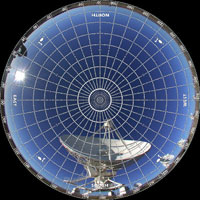In this multi-page blog post, I’m going to address some of the issues behind our policy of shipping only ready-to-play fulldome movies to our customers, and not dome masters.
As show producers, we pour our hearts and souls into creating the best-looking and best-sounding shows we can create. Our writers hone our scripts, our artists render visuals to illustrate those scripts, and our musicians shape compositions to embellish our soundtracks. The show is an audiovisual assemblage of artistry, ideas and emotions, made from the talents of a few, for the ultimate enjoyment of many.
Here at Loch Ness Productions, we’ve been putting ourselves through this creation process for more than thirty years, gaining experience as we go.
Once the creative part of the production has ended, we have our “master” set of images and soundtrack. Out of the many is distilled the one. Now comes the more mundane — different but still important — task: shaping that master set into the movies we ship out to customers.
Out with the Old, In with the New
In the olden days of LNP classic planetarium show packages, our work was shipped more like a kit than a turnkey show presentation (though we took pains not to call it a kit). We would have to assemble and collate boxes of 35mm slides, dub soundtrack tapes in a plethora of formats, and print script and production notes along with directions for the customer about how to put it all together. The end result that got presented to audiences was almost never as good as we had planned. Our efforts at taking the productions to the nth degree were often compromised, either by the customer’s theater configuration, a lack of some projector or another, or the user’s abilities to program an automation system (if there even was one). Unfortunately, in no way could we be assured audiences would see what we intended. There simply was no practical method of quality control.
With fulldome, we’ve happily progressed beyond those old ways.
Oh, we still work with the same billions of pieces of the show as always — the script/soundtrack, and visuals. But instead of rendering the visuals to film as panoramas, all-skies, and single-shot frames, our visuals are now rendered out as a sequence of image frames. Instead of rendering the audio mixes to tape, we render out WAV files. We still end up with a “master” set of images and soundtrack.
 Those image frames are commonly called “dome masters”. We merge the dome masters with the audio, and render out movie files. Those ready-to-play movies are the finished end-product; they’re what we ship. They’re what we want audiences to see and hear.
Those image frames are commonly called “dome masters”. We merge the dome masters with the audio, and render out movie files. Those ready-to-play movies are the finished end-product; they’re what we ship. They’re what we want audiences to see and hear.
We’ve already done all the work that used to be required of the classic planetarium operator. Fulldome allows us an efficient method of distributing our baby, and the end-user an expeditious method of displaying it. We didn’t have that back in the photographic film days of yore.
We can now be assured that the audience has a decent chance of seeing and hearing the show as we meant for it to be, because we’re able to ship those ready-to-play movies to our customers. We can run them through our quality-control checks before we send them out. We no longer have to ship the customer pieces and parts, then spin our prayer wheels and hope for the best.
We try to make it as simple as possible for the customers, to minimize the possibility of something going wrong when they install the show on their playback systems.
But…
Page 1 – Masters of the Dome Masters
Page 2 – But…
Page 3 – The Reasons for Not Shipping Frames
Page 4 – It’s the hardware
Page 5 – A Sense of Entitlement
Page 6 – Don’t panic!

